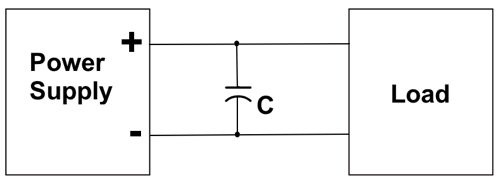In many applications, a DC power supply has to drive a load with a large ripple component. Examples of this type of load are DC-AC inverters, DC-DC converters, and DC motor loads. Linear supplies can normally handle this kind of load easily, but when you use a switching power supply, such as the Sorensen SG Series or Sorensen ASD Series, to drive this type of load, you may encounter some unexpected (and undesirable) problems.
The reason for this is that, unlike linear supplies, power is not continuously delivered to the output storage capacitors. Instead, a switching supply delivers power to the output capacitors in “packets” at a regular rate (switching frequency). When the load is steady, it is relatively easy for the switching supply to keep the output capacitor “topped up” and maintain a steady output.
When the load is not steady, however, it may discharge the output capacitor by a significant amount before the switching supply's control loop can increase the current to the output capacitors to meet the new load requirement. Since the voltage on the output capacitor will have dropped, the switching supply would have to supply a very high current to the output capacitors to bring the output voltage back to the set voltage. Since the switching supply's converter output is current-limited, it may take several cycles to recharge the capacitors.
A high ripple current can cause other problems. For example, if the ripple is more than about 5% of the DC output current, the switching power supply may interpret this current draw as a fault condition and the over-current protection circuits may shut down the supply. If the pulse rate of the load is harmonically related to the power supply switching frequencies, the load could cause instability in the control loops. High ripple currents can also seriously over stress the switching supply's output and cause them to fail early.
Practical solution
The most practical solution to most of these problems, as shown in the figure below, is to connect a capacitor with a low equivalent series resistance (ESR) to the switching supply's output so that the supply sees a steady DC load. The capacitance needs to be high enough to limit the ripple voltage to significantly less than 5% of the operating output voltage.
You can compute the needed capacitance from the peak output current and allowing, say, 2.5% of the operating output voltage as ripple; the duty cycle; and frequency of the load.
C = ((t/.025) x Vout) x Ipk = ((40 x t) / Vout) x Ipk
where: C = farads, t = seconds, V = Volts, and I = amperes.
Generally, the capacitance will run between 1000 uF and 10,000 uF per amp of peak load current. The lower the output voltage, the higher the capacitance you will need.
When selecting an external capacitor, be sure to select one that is rated “computer grade.” Computer-grade capacitors have low ESR and can tolerate very high ripple currents. Typically, these capacitors will have screw terminals. Install them between the switching power supply and the load, and run the leads from the power supply output terminals to the capacitor terminals. Then, run a second set of leads from the capacitor to the load, forcing the current to flow through the capacitor terminals.
For more information, visit the AMETEK Programmable Power website.





